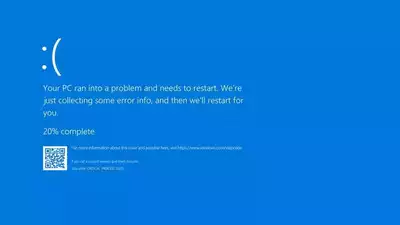‘Blue Screen of Death (#BSOD)’: Windows users face massive outage after new Crowdstrike update.

Todays, Microsoft Windows users worldwide have been grappling with a severe issue: the infamous Blue Screen of Death (BSOD). This error has thrown countless laptops and PCs into a chaotic restart loop, causing significant disruptions not only to individual users but also to businesses and critical infrastructures. The situation has escalated to the point where it has impacted industries as varied as airlines and media companies, underscoring the pervasive reliance on Microsoft’s operating systems.
The Initial Outbreak: A Digital Catastrophe
Reports of the BSOD errors first began to surface on X (formerly Twitter), with users from various parts of the world expressing their frustration and concern. The blue screen errors rendered their devices unusable, often trapping them in a relentless cycle of restarting and failing to boot properly. These problems were soon linked to a latest update from Crowdstrike, a cybersecurity firm known for its cloud-based security solutions.
Crowdstrike’s update, specifically an overnight change to their Falcon sensor, was identified as the culprit behind the malfunction. The company has acknowledged the issue and is working on a solution, but for many users, the damage had already been done. Screenshots of error messages and desperate pleas for help flooded social media, painting a grim picture of the widespread chaos.
Frontier Airlines: Grounded by a Digital Failure
One of the most high-profile casualties of this digital mishap was Frontier Airlines. The Wall Street Journal reported that the airline had to cancel several flights due to the Microsoft outage. In a statement, Frontier Airlines acknowledged the significant impact on their systems and expressed gratitude for their customers' patience during this challenging period. The airline’s reliance on Windows-based systems for critical operations like scheduling, check-ins, and customer service meant that the BSOD issue had a direct and immediate effect on their ability to function.
Microsoft 365: Disrupted Workflows
Adding to the woes, Microsoft 365 users also faced significant disruptions. The Microsoft 365 Status account on X posted that the company was investigating the issue affecting users' ability to access various Microsoft 365 apps and services. They mentioned that efforts were underway to reroute impacted traffic to alternate systems to mitigate the problem. The outage of such a widely used suite of applications exacerbated the issue, as businesses and individuals relying on tools like Outlook, Teams, and Word found themselves unable to work efficiently.
Social Media Erupts: A Global Echo Chamber
The response on social media platforms was swift and widespread. Users from across the globe shared their experiences and sought solutions in a collective attempt to understand and address the problem. One user on X highlighted the surreal nature of the situation, noting that multiple media outlets had reached out within minutes to report their systems experiencing BSOD errors simultaneously. Another user from Malaysia reported that 70% of their company's laptops were down, prompting a company-wide shutdown order from their headquarters in Japan.
Reddit also became a hub for discussions and troubleshooting tips. One user suggested a temporary fix involving renaming the Crowdstrike folder from the command prompt in recovery mode, a solution that provided some relief to affected users. This ad-hoc fix underscored the desperation and resourcefulness of users trying to regain control of their systems amidst the turmoil.
A Multi-Sector Impact: From Banks to Media
The BSOD crisis did not discriminate in its impact. Banking institutions, supermarkets, and media companies in the United States reported significant disruptions. TV and radio studios were particularly hard-hit, with some going offline entirely, according to The Guardian. The sudden and widespread nature of the outage highlighted the interconnectedness of modern digital infrastructures and the potential vulnerabilities therein.
In India, large multinational companies faced similar issues, with one top executive telling the Hindustan Times that their network of Windows-based desktops and laptops was severely affected. The reliance on Microsoft's operating system across various sectors meant that the impact was far-reaching and deeply felt.
The Technical Breakdown: Crowdstrike’s Falcon Sensor
The root of the issue was traced back to Crowdstrike’s Falcon sensor update. Crowdstrike, a well-respected name in cybersecurity, provides a range of services designed to protect systems from a myriad of threats. However, this particular update introduced an unforeseen conflict with Windows systems, leading to the dreaded BSOD errors.
A technical analysis revealed that the Falcon sensor update caused a critical failure in the boot process of Windows machines. This failure prevented the operating system from loading correctly, triggering the blue screen errors and the subsequent restart loops. Crowdstrike has since been working on a patch to rectify the problem, but the process of deploying and ensuring the effectiveness of such updates takes time.
The Response: Damage Control and Solutions
In response to the crisis, both Microsoft and Crowdstrike have mobilized their resources to address the issue. Microsoft's immediate focus has been on rerouting affected traffic and providing support to users grappling with the BSOD errors. Their efforts to ensure that alternate systems can handle the load of rerouted traffic are crucial in maintaining continuity for Microsoft 365 users.
Crowdstrike, on the other hand, has been working on a more permanent fix for the Falcon sensor issue. Their technical teams are likely engaged in a thorough investigation to understand the root cause and prevent similar incidents in the future. The incident has also prompted discussions about the importance of robust testing and contingency planning for updates, particularly those affecting critical system components.
Lessons Learned: The Importance of Resilience
The widespread impact of the BSOD errors underscores several important lessons for both users and providers of digital technologies. For businesses, the incident highlights the need for resilience and contingency planning. Relying heavily on a single operating system or service can create significant vulnerabilities, as demonstrated by the cascading effects of the Microsoft outage.
For software providers like Microsoft and Crowdstrike, the incident serves as a reminder of the critical importance of rigorous testing and the potential ramifications of software updates. Ensuring that updates do not inadvertently disrupt system functionality is paramount, especially when dealing with products used by millions of people worldwide.
The Path Forward: Recovery and Prevention
As the dust begins to settle, the focus will shift towards recovery and prevention. Affected users will need to apply the necessary updates and fixes provided by Crowdstrike and Microsoft to restore their systems to full functionality. This process may take time, particularly for large organizations with extensive networks of devices.
In the longer term, both companies and individual users will likely reassess their digital strategies. This may include diversifying their technological ecosystems to reduce reliance on a single provider, implementing more robust backup systems, and enhancing their cybersecurity measures to protect against similar incidents in the future.
Conclusion: A Sobering Reminder
Todays BSOD crisis serves as a sobering reminder of the vulnerabilities inherent in our increasingly digital world. As we continue to rely on technology for everything from personal communication to critical business operations, the importance of resilience, robust testing, and contingency planning cannot be overstated. The collaborative efforts of Microsoft, Crowdstrike, and the global community of users in responding to this crisis offer hope for a swift recovery and a more resilient digital future.


